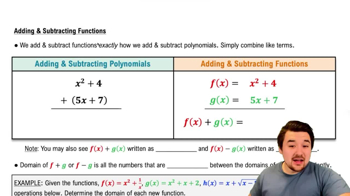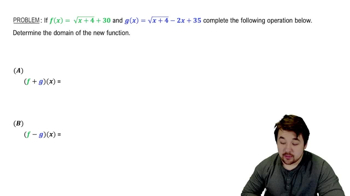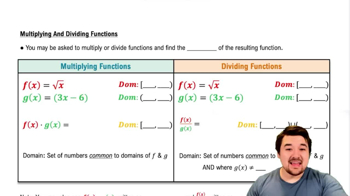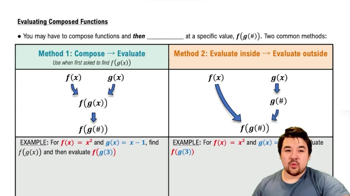Table of contents
- 0. Functions7h 52m
- Introduction to Functions16m
- Piecewise Functions10m
- Properties of Functions9m
- Common Functions1h 8m
- Transformations5m
- Combining Functions27m
- Exponent rules32m
- Exponential Functions28m
- Logarithmic Functions24m
- Properties of Logarithms34m
- Exponential & Logarithmic Equations35m
- Introduction to Trigonometric Functions38m
- Graphs of Trigonometric Functions44m
- Trigonometric Identities47m
- Inverse Trigonometric Functions48m
- 1. Limits and Continuity2h 2m
- 2. Intro to Derivatives1h 33m
- 3. Techniques of Differentiation3h 18m
- 4. Applications of Derivatives2h 38m
- 5. Graphical Applications of Derivatives6h 2m
- 6. Derivatives of Inverse, Exponential, & Logarithmic Functions2h 37m
- 7. Antiderivatives & Indefinite Integrals1h 26m
- 8. Definite Integrals4h 44m
- 9. Graphical Applications of Integrals2h 27m
- 10. Physics Applications of Integrals 2h 22m
0. Functions
Combining Functions
Problem 87e
Textbook Question
Composition of even and odd functions from graphs Assume ƒ is an even function and g is an odd function. Use the (incomplete) graphs of ƒ and g in the figure to determine the following function values. <IMAGE>
e. g(g(-7))
 Verified step by step guidance
Verified step by step guidance1
Step 1: Understand the properties of even and odd functions. An even function satisfies f(x) = f(-x) for all x, and an odd function satisfies g(x) = -g(-x) for all x.
Step 2: Identify that g is an odd function. This means that for any input x, g(x) = -g(-x).
Step 3: Evaluate g(-7) using the property of odd functions. Since g is odd, g(-7) = -g(7).
Step 4: Use the result from Step 3 to evaluate g(g(-7)). Substitute g(-7) with -g(7) in the expression g(g(-7)).
Step 5: Evaluate g(-g(7)) using the property of odd functions again. Since g is odd, g(-g(7)) = -g(g(7)).
 Verified video answer for a similar problem:
Verified video answer for a similar problem:This video solution was recommended by our tutors as helpful for the problem above
Video duration:
3mPlay a video:
Was this helpful?
Key Concepts
Here are the essential concepts you must grasp in order to answer the question correctly.
Even Functions
An even function is defined by the property that f(x) = f(-x) for all x in its domain. This symmetry about the y-axis means that the graph of an even function is mirrored on either side of the y-axis. Common examples include f(x) = x² and f(x) = cos(x). Understanding this property is crucial for analyzing the behavior of even functions in compositions.
Recommended video:
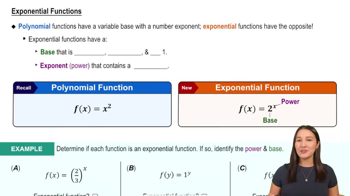
Exponential Functions
Odd Functions
An odd function satisfies the condition g(x) = -g(-x) for all x in its domain, indicating symmetry about the origin. This means that if you rotate the graph 180 degrees around the origin, it remains unchanged. Examples include g(x) = x³ and g(x) = sin(x). Recognizing this property is essential for evaluating compositions involving odd functions.
Recommended video:

Properties of Functions
Function Composition
Function composition involves applying one function to the result of another, denoted as (f ∘ g)(x) = f(g(x)). This process requires understanding how the output of the inner function becomes the input for the outer function. In the context of the question, evaluating g(g(-7)) necessitates first finding g(-7) and then using that result as the input for g again, highlighting the importance of sequential function evaluation.
Recommended video:

Evaluate Composite Functions - Special Cases

 5:56m
5:56mWatch next
Master Adding & Subtracting Functions with a bite sized video explanation from Nick
Start learning
